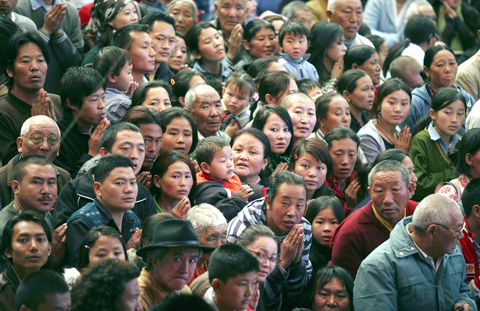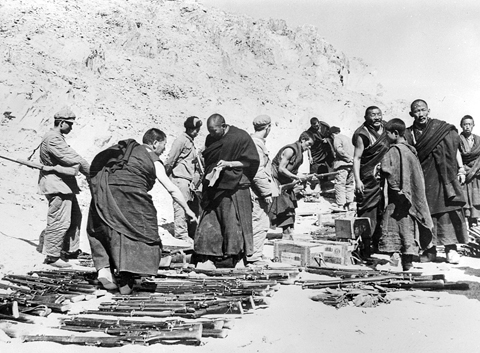Amid growing anger among Tibetan exiles at China’s subjugation of Tibet and its monasteries, bitter memories of a failed armed struggle haunt former guerrilla fighter Lhasang Tsering.
Over five decades, the Tibetan movement has drawn international attention and support for being among the world’s rare non-violent struggles, which has been credited to the Dalai Lama’s “middle way” approach, which stresses conciliatory negotiations with China.
Although the policy has made little headway with Beijing, the Dalai Lama was awarded the Nobel Peace Prize in 1989 for leading Tibet’s non-violent struggle.

PHOTO: AP
Against such a backdrop, 15 years of a violent conflict for Tibetan independence beginning in the late 1950s is looked at as a “deviation” that many Tibetans do not like to talk about.
With the passage of time and the fighters fading into congested refugee settlements, the episode has nearly been forgotten and is spoken about only in hushed tones.
But for Tsering, the armed struggle is as real as the day he joined it in northern Nepal’s Mustang district in 1972.

PHOTO: AFP
Among the prominent dissidents of the Tibetan diaspora, Tsering once worked with the Tibetan government-in-exile but resigned in 1990 to protest the Dalai Lama’s decision to give up the demand for an independent Tibet in favor of seeking autonomy within China.
A slight man with a goatee, Tsering, who also headed the Tibetan Youth Congress, has for decades criticized the middle way policy of the Dalai Lama.
“From my moral standpoint, the non-violence in surrendering to an evil is far worse than the use of violence to overcome the evil,” said Tsering, who now runs a bookshop in Mcleodganj, a suburb of Dharamsala, India.
If Tibetans do not defend themselves against a “colonial China,” they would one day disappear like the Inca civilization in South America, said the former fighter, who is now in his mid-50s.
The armed resistance against the Chinese began after the invasion of Tibet’s eastern Kham and Amdo regions by the People’s Liberation Army in the 1950s.
The Khampa fighters of the region announced the formation in 1958 of the Chushi Gangdruk — which means “four rivers, six ranges” and refers to Kham — to stop the Chinese army’s advance into Lhasa.
When the March 10, 1959, uprising against the Chinese failed, the Gangdruk guerrillas helped the Dalai Lama flee to India, Tsering said, adding that the fighters then retreated to Mustang, from where they conducted raids into Tibet and waged war with the Chinese army for 15 years.
At its peak, the force consisted of an estimated 2,000 Tibetans and received support like arms, ammunition and training from the CIA.
“We were certainly few to win against the Chinese but enough to create a lot of problems for them,” he said.
But with the US government’s rapprochement with China, aid and supplies from the CIA began to wane in the late 1960s. Nepalese troops also began a crackdown to crush the fighters.
Chushi Gangdruk’s operations finally ceased in 1974 after the Dalai Lama taped a message telling the fighters to lay down their weapons and surrender.
“The fighters could not say no to the Dalai Lama, but several committed suicide as they had vowed to fight to the bitter end,” Tsering said, choked with emotion and with tears in his eyes. “They could find freedom and dignity only in death.”
Others were arrested, killed or escaped.
Tsering still justified an armed struggle for his homeland and said he would be ready to put his “life on the line” were there an opportunity.
“It takes two to shake hands, but the Chinese found no need to shake hands with a bunch of helpless refugees,” he said, adding as an afterthought: “It takes only one to deliver a punch.”
Tsering said the exiled Tibetans have been confused and frustrated with talks with China because their movement lacks clarity of purpose. Frustration has also grown after the lack of progress after 50 years of exile following the flight of the Dalai Lama from Tibet on March 17, 1959.
Mentioning that Tibetans in Tibet were sacrificing their lives for independence, Tsering pointed toward the residence of the Dalai Lama and said: “If only the holy one would restore clarity of purpose and return to the cause of freedom.”
“He is our spiritual leader, and Tibetans are not in a position where they can question His Holiness, but to force Tibetans to choose between freedom and faith is not right,” Tsering said.

Former Nicaraguan president Violeta Chamorro, who brought peace to Nicaragua after years of war and was the first woman elected president in the Americas, died on Saturday at the age of 95, her family said. Chamorro, who ruled the poor Central American country from 1990 to 1997, “died in peace, surrounded by the affection and love of her children,” said a statement issued by her four children. As president, Chamorro ended a civil war that had raged for much of the 1980s as US-backed rebels known as the “Contras” fought the leftist Sandinista government. That conflict made Nicaragua one of

COMPETITION: The US and Russia make up about 90 percent of the world stockpile and are adding new versions, while China’s nuclear force is steadily rising, SIPRI said Most of the world’s nuclear-armed states continued to modernize their arsenals last year, setting the stage for a new nuclear arms race, the Stockholm International Peace Research Institute (SIPRI) said yesterday. Nuclear powers including the US and Russia — which account for about 90 percent of the world’s stockpile — had spent time last year “upgrading existing weapons and adding newer versions,” researchers said. Since the end of the Cold War, old warheads have generally been dismantled quicker than new ones have been deployed, resulting in a decrease in the overall number of warheads. However, SIPRI said that the trend was likely

NUCLEAR WARNING: Elites are carelessly fomenting fear and tensions between nuclear powers, perhaps because they have access to shelters, Tulsi Gabbard said After a trip to Hiroshima, US Director of National Intelligence Tulsi Gabbard on Tuesday warned that “warmongers” were pushing the world to the brink of nuclear war. Gabbard did not specify her concerns. Gabbard posted on social media a video of grisly footage from the world’s first nuclear attack and of her staring reflectively at the Hiroshima Peace Memorial. On Aug. 6, 1945, the US obliterated Hiroshima, killing 140,000 people in the explosion and by the end of the year from the uranium bomb’s effects. Three days later, a US plane dropped a plutonium bomb on Nagasaki, leaving abut 74,000 people dead by the

Indian Prime Minister Narendra Modi is to visit Canada next week, his first since relations plummeted after the assassination of a Canadian Sikh separatist in Vancouver, triggering diplomatic expulsions and hitting trade. Analysts hope it is a step toward repairing ties that soured in 2023, after then-Canadian prime minister Justin Trudeau pointed the finger at New Delhi’s involvement in murdering Hardeep Singh Nijjar, claims India furiously denied. An invitation extended by new Canadian Prime Minister Mark Carney to Modi to attend the G7 leaders summit in Canada offers a chance to “reset” relations, former Indian diplomat Harsh Vardhan Shringla said. “This is a